Agathosma dielsiana
Agathosma dielsiana Schltr. ex Dummer
Family: Rutaceae
Common names: Diels buchu (Eng.); Diels-boegoe (Afr.)
Introduction
A floriferous, water-wise and hardy small shrub, ideal for that sunny patch or pot. It is native to sandy or limestone areas close to the sea in fynbos-vegetation.
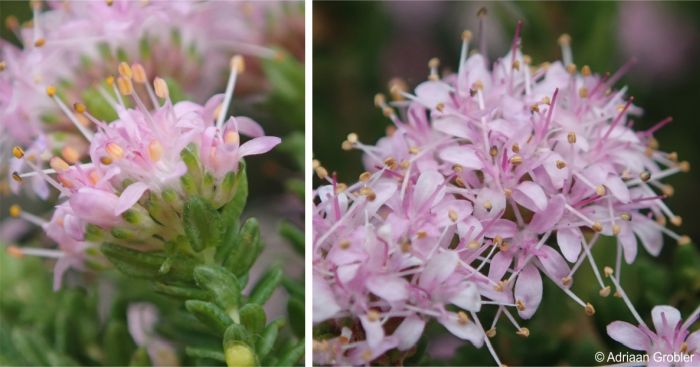
Description
Description
Variable, bushy, aromatic shrub from 0.2–1.7 m tall and about 500 mm wide. Small soft hairs cover the stems. The leaves are fine, with rolled-under margins and conspicuous oil glands. Mauve or white flowers are carried in dense terminal clusters from early autumn to mid spring (April to October). Fruit is 3-chambered.
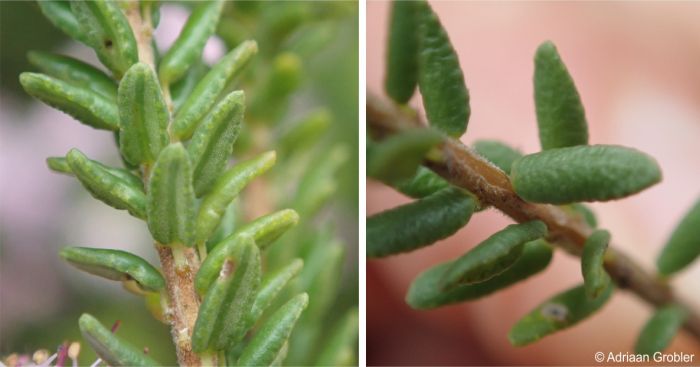
Conservation Status
Status
This species currently has no threats and is afforded the conservation status of Least Concern (LC) by the Red List of South African plants.
Distribution and habitat
Distribution description
This species is common from the dune zone to the more elevated limestone hills, between 5-185 m, from Bredasdorp on the Agulhas Plain to George in the Garden Route, in the Western Cape.
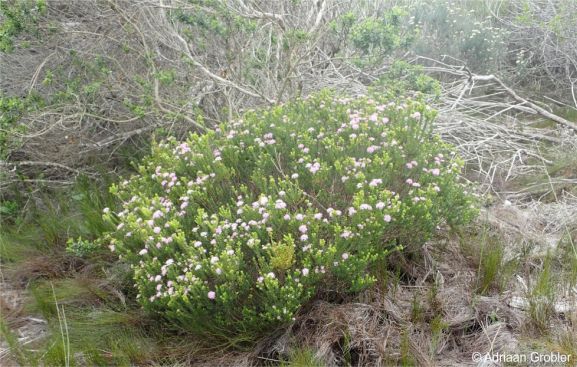
Derivation of name and historical aspects
History
The genus name Agathosma, is derived from the Greek, agathos, which means ‘good’ and osme, which refers to ‘fragrance’. This indicates the distinctive aromatic foliage so typical of the genus. The specific epithet dielsiana honours the German botanist Friedrich Ludwig Emil Diels (24 September 1874 – 30 November 1945). Between 1900 and 1902 he and fellow botanist Ernst Pritzel made several collections in South Africa, Australia, New Zealand and Java. His collections, which included many holotypes, made of Australian and Ecuadorian species, vastly enriched the knowledge of these floras. In 1913 he became the vice-director, and later director from 1921 until 1945, of the Berlin-Dahlem botanical garden. The majority of his collections were stored in the herbarium of this garden. However, in an air-raid during the Second World War, most of his collections were destroyed. Diels is arguably best remembered for his monography of Droseraceae published in 1906, which remains the standard, and his joint-publication with Pritzel called Fragmenta Phytographiae Australiae Occidentalis which featured a key-description of West-Australian plant species.
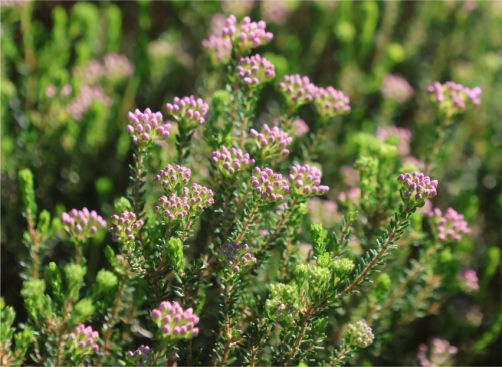
The Rutaceae, or citrus family, is well known for its variety of citrus and the crops play a crucial economic role in agriculture and other industries. The family is common throughout temperate and tropical regions of the world, in particular South Africa and Australia. There are at present some 160 genera recognized and a total of 1 650 species. In southern Africa 21 genera and 301 species call it home. This includes the genera Calodendron, Zanthoxylum, Vepris, Acmadenia, Agathosma and Adenandra. All South African species belong to the subfamily Diosmeae. Species in this particular subfamily are shrubs with simple leaves and unique fruits made up of 1–5 free carpels and characterized by horn-like processes at the apex. The carpels undergo a complete separation at maturity, when each carpel splits down an inward-facing line. The seeds are subsequently released in an extremely powerful manner because of the hygroscopic properties of the inner layer of the wall. The Western Cape is home the highest diversity of species in South Africa, including Agathosma, Coleonema, Acmadenia and Adenandra. The genus Agathosma consists of roughly 150 species of evergreen, large to small shrubs, with flowers anything from usually pink white or purple.
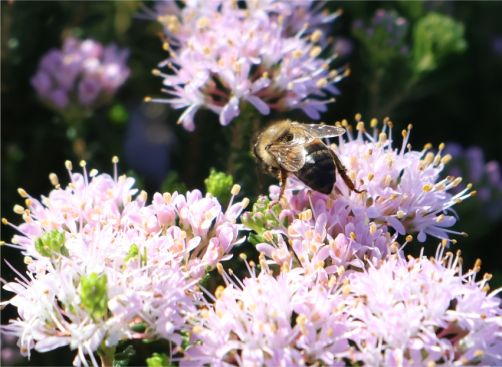
Ecology
Ecology
Aromatic oil glands are present in the leaves of this species, this is characteristic of all members in the family Rutaceae. Butterflies and bees have been observed visiting this species, however it cannot be stated with certainty that they are crucial cogs the pollination-process.
Uses
Use
There are no medicinal uses recorded for this species. Agathosma dielsiana has great potential as a landscaping ornamental and is a wonderful addition to the Buchu Garden at Kirstenbosch NBG.

Growing Agathosma dielsiana
Grow
The author has never propagated this species from seed and there is no record of it being done at Kirstenbosch NBG. However, should you be able to obtain seed, the propagation-method is fairly easy. Sow the seed in autumn in a light, well-draining medium such as coarse river sand or equal parts of sand and compost. Cover seeds with a thin layer of either bark or sand, and then water. Place the seed tray in a covered area that provides sufficient ventilation and good light. Never allow the medium to dry out completely or be overwatered. Germination can take between 4 and 9 weeks for most buchu species, and the appearance of the first 4 true leaves indicate that the seedlings are ready for pricking out. Handle the fragile, fine roots with care. Place the potted seedlings then in a shady area for about a month to harden them off, before shifting them to the full sun. The young seedlings can also have its growing tips pinched out to encourage a more bushy growth habit. Regularly feed the seedlings with some balanced organic fertilizers.
This species can be propagated by vegetative means, by taking cuttings. Use fresh material of the current year’s growth to take cuttings of between 25 and 55 mm. Remove about a third of the foliage and nip the cuttings below the node. Dip cuttings in a rooting hormone for semi-woody shrubs or perennials and place in trays with a medium consisting of coarse river sand or equal parts of bark and polystyrene, whichever is available. Place the cuttings in a mist-unit with heated benches. Pot the rooted cuttings into a well-drained mix and then transfer it to a shady area for roughly a month, to harden off before moving it into the sun. In another 7–8 months plants are ready for planting out in the garden.
Agathosma dielsiana is best-suited to full sun and well-drained, sandy soil. Planting out is best done in the rainy season between autumn and winter. In areas where there is rainfall throughout the year, gardeners can adjust to their local conditions. In general, planting out during the rainy will enable plants to have a better chance of establishing themselves properly before they have to cope with the harsh, dry conditions in summer. Maintain the planting intervals of 200–300 mm for buchus and this should provide enough space to encourage growth. This relatively dense planting is preferred by buchus, as it aids in retaining soil moisture. Provide a good thorough watering in autumn and winter, depending on the prevailing rainfall following planting. In summer, during the dry season, the irrigation should just be moderate; however, plants must never be allowed to dry out completely. Mulching also helps in keeping the roots and soil cool during the dry periods.
Plant this buchu with other fynbos species, which may include: Agathosma collina, A. apiculata, A. gonaquensis, Acmadenia mundiana, Adenandra gummifera, Acmadenia heterophylla, Euchaetis albertiniana, Coleonema album, Leucospermum muirii, L. patersonii, L. prostratum, Protea compacta, P. repens, P. acaulos, P. coronata, P. cynaroides, P. obtusifolia, Erica baueri subsp. baueri, E. baueri subsp. gouriqua, E. coccinea subsp. coccinea, Erica cruenta, Pelargonium cucculatum, P. capitatum, P. betulinum, Felicia filifolia, F. erigeroides, F. aethiopica, Salvia aurea, S. africana, Restio dispar, R. multiflorus, Elegia fenestrata, E. filacea, E. fistulosa, Dimorphtheca pluvialis, Ursinia anthemoides subsp. anthemoides, Senecio elegans, S. arenarius, Delosperma littorale, Cotyledon orbiculata, Carprobrotus mellei, C. muirii, C. edulis subsp. edulis and Oedera imbricata.
No pests have been recorded.
References
- Bohnen, P. 1986. Flowering plants of the southern Cape. The Sill Bay Trust, Still Bay.
- Bond, P. & Goldblatt, P. 1984. Plants of the Cape flora. A descriptive catalogue. Journal of South African Botany Suppl. Vol. 13, National Botanic Gardens of South Africa, Kirstenbosch, Cape Town.
- Encyclopedia of Australian Science and Innovation. Diels, Friedrich Ludwig Emil (1874-1945). https://www.eoas.info/biogsP005237b.htm. Accessed on 9 July 2024.
- Germishuizen, S., Meyer, N.L., Steenkamp, Y. & Keith, M. (eds) 2006. A checklist of South African plants. Southern African Botanical Diversity Network Report No.41. SABONET, Pretoria.
- Grobler, A. 2018-09. Observation of Agathosma dielsiana, Geelkrans Nature Reserve, Western Cape. iNaturalist. Online. https://www.inaturalist.org/observations/19635314.
- Jodamus, N. 2003-7. Agathosma crenulata (L.) Pillans (Rutaceae).PlantZAfrica. Online. http://pza.sanbi.org./agathosma-crenulata.
- Lucas, N. 2008. Agathosma capensis (L.) Dummer (Rutaceae). PlantZAfrica. Online. http://pza.sanbi.org/agathosma-capensis.
- Manning, J. & Goldblatt, P. 2012. Plants of the Greater Cape Floristic Region 1: the Core Cape Flora. Strelitzia 29. South African National Biodiversity Institute, Pretoria.
- Oliver, R. 2016-7. Agathosma ciliaris. (L.) Druce (Rutaceae). PlantZAfrica. Online. http://pza.sanbi.org.za/agathosma-ciliaris.
- Raimondo, D., Von Staden, L., Foden, W., Victor, J.E., Helme, N.A., Turner, R.C., Kamundi, D.A. & Manyama, P.A. (eds) 2009. Red list of South African plants. Strelitzia 25. South African National Biodiversity Institute, Pretoria.
- Stearn, W. 2002. Stearn's dictionary of plant names for gardeners. Timber Press, Portland, Oregon.
- Wikipedia. Ludwig Diels. http://en.wikipedia.org/wiki/Ludwig_Diels. Accessed on 9/7/2024.
Credits
Roger Oliver
Kirstenbosch National Botanical Garden
August 2024
Acknowledgements: additional images by Adriaan Grobler.
Plant Attributes:
Plant Type: Shrub
SA Distribution: Western Cape
Soil type: Sandy, Loam
Flowering season: Spring, Winter
PH: Acid, Alkaline, Neutral
Flower colour: White, Pink, Mauve/Lilac
Aspect: Full Sun
Gardening skill: Easy
Special Features:
Horticultural zones








Rate this article
Article well written and informative
Rate this plant
Is this an interesting plant?
Login to add your Comment
Back to topNot registered yet? Click here to register.